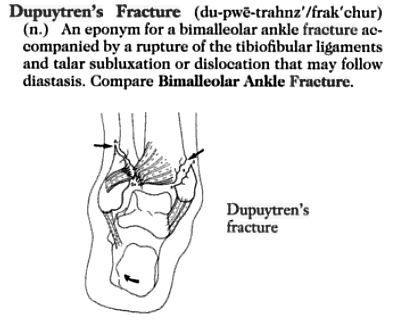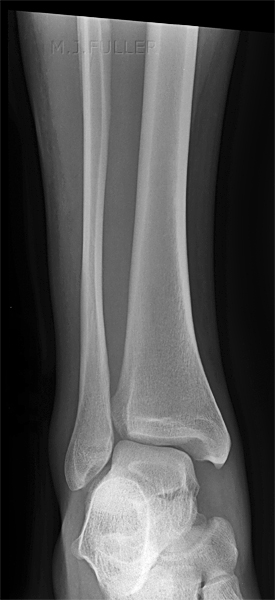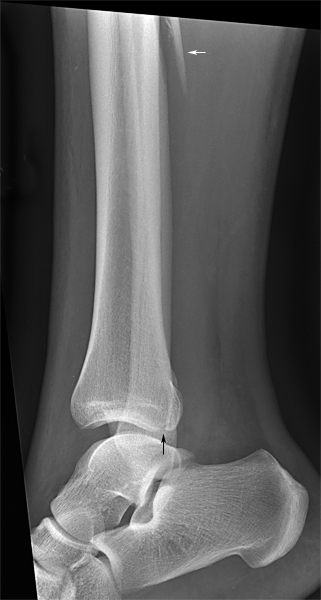Dupuytren's Fracture
Dupuytren's fracture is named after the French Surgeon Guillaume Dupuytren (1777–1835) who was considered to be one of the greatest French surgeons of the 19th century. Referring to fractures by an eponym is notoriously hazardous and this is no exception. Dupuytren's fracture is frequently referred to as an archaic term and its exact definition today is unclear. Not unlike other popular eponyms such as Colle's Fracture and Pott's fracture, the term's meanings have changed over time.
Dupuytren's fracture should not be confused with Dupuytren's contracture for which he is better known.
Definition
The following are a variety of definitions of Dupuytren's fracture
Dupuytren Fracture
Dupuytren fracture is an archaic term used for many types of bimalleolar ankle fractures. The term is commonly used to refer to a fracture of the distal portion of the fibula above the lateral malleolus, with an associated tear of the tibiofibular ligaments and the deltoid ligament. There is lateral displacement of the talus and a possible medial malleolus fracture as well
<a class="external" href="http://radiographics.rsnajnls.org/cgi/content/full/20/3/819#REF2" rel="nofollow" target="_blank">Tim B. Hunter, MD, Leonard F. Peltier, MD, PhD and Pamela J. Lund, MD Musculoskeletal Eponyms: Who Are Those Guys? Radiographics. 2000;20:819-736.</a>
<a class="external" href="http://www.jbjs.org.uk/cgi/reprint/53-B/1/63" rel="nofollow" target="_blank">C. L. COLTON. THE TREATMENT OF DUPUYTREN’S FRACTURE-DISLOCATION
OF THE ANKLE. The Journal of Bone and Joint Surgery. vol. 53 B, NO. 1, FEBRUARY 1971</a>
If I can glean some common ground from these definitions of Dupuytren's fracture, it appears that there is: a fracture of the fibula (mid to lower third); ankle ligament disruption medially; and diastasis of the ankle joint. (the last definition is fairly clear and intelligible)
Cases
Comment
Unless there is clear and universal understanding of the meaning of a fracture referred to by an eponym, it is probably best not to use the eponym when referring to the fracture. What is preferable is to describe the fracture- this is likely to impart more information about the fracture, and does not rely on the person at the receiving end knowing the eponym that you are referring to. Dupuytren described this fracture back at the time of the French revolution..there are arguably better ways to describe ankle fractures and ankle fracture/dislocations today.
... back to the Wikiradiography Home page
... back to the Applied Radiography page





